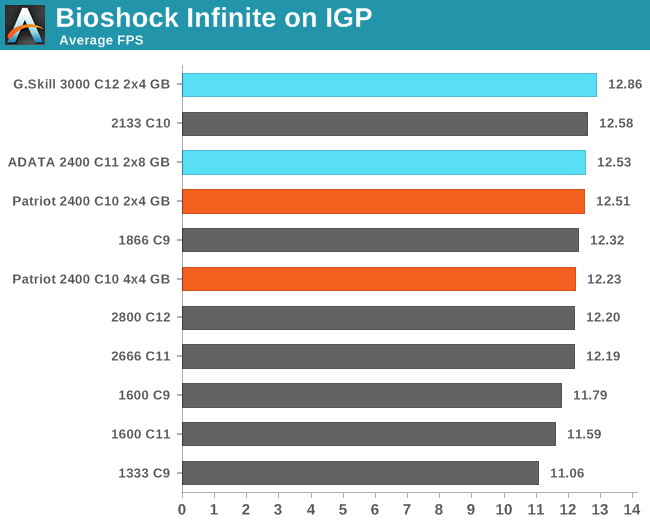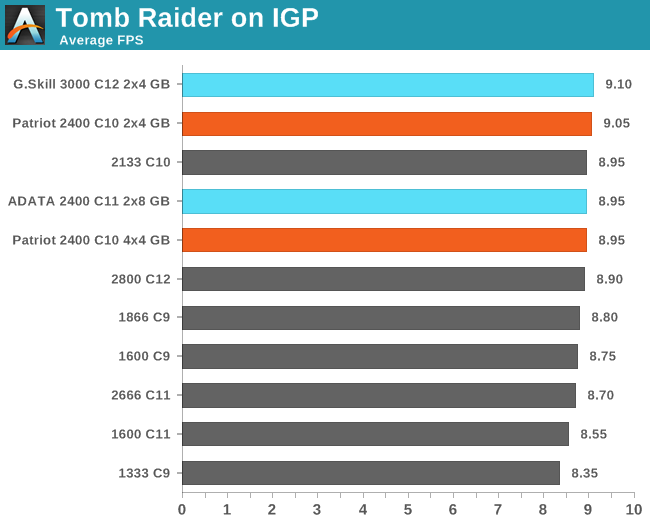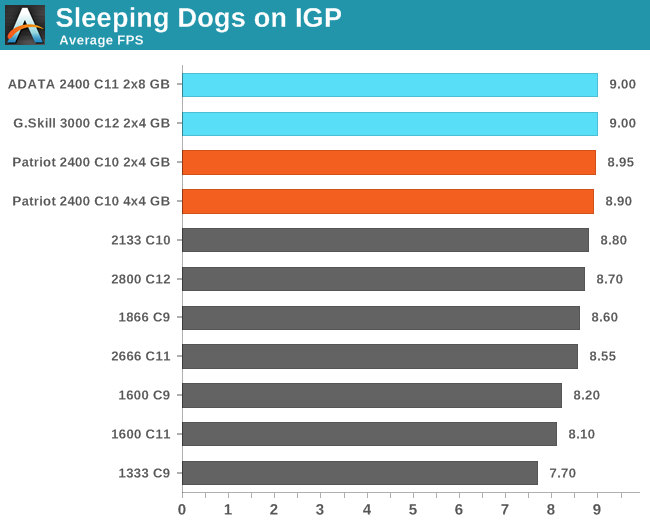Patriot Viper III Review: 2x4 GB at DDR3-2400 C10-12-12 1.65 V
by Ian Cutress on November 18, 2013 1:00 PM ESTIGP Gaming
The activity cited most often for improved memory speeds is IGP gaming, and as shown in both of our tests of Crystalwell (4950HQ in CRB, 4750HQ in Clevo W740SU), Intel’s version of Haswell with the 128MB of L4 cache, having big and fast memory seems to help in almost all scenarios, especially when there is access to more and more compute units. In order to pinpoint where exactly the memory helps, we are reporting both average and minimum frame rates from the benchmarks, using the latest Intel drivers available. All benchmarks are also run at 1360x768 due to monitor limitations (and makes more relevant frame rate numbers).
Bioshock Infinite

Tomb Raider

Sleeping Dogs

For IGP gaming, the Patriot kit seems to do well in both memory configurations, except in Bioshock Infinite minimum FPS where there seems to be a group of memory settings at the bottom.










48 Comments
View All Comments
chekk42 - Tuesday, November 19, 2013 - link
No, I wasn't expecting 2400 to come in CL7, but thanks for the assistance. My point is really that kits which qualify as low latency like many of those in your list, seem to be in very short supply and/or very expensive today. I don't think this was the case a couple years ago when there was higher availability.Gen-An - Tuesday, November 19, 2013 - link
The ICs that could run at those latencies comfortably have long since been discontinued. They were mostly 1Gbit chips (128MB) made by Elpida and Powerchips, so the biggest sticks you could get out of them were 2GB. Most memory these days are 4GB and 8GB sticks and the ICs used can't run low latencies at speeds of 1600.djscrew - Tuesday, November 19, 2013 - link
RAM reviews seem more and more pointless by the day.Dustin Sklavos - Tuesday, November 19, 2013 - link
Honestly I thought that for a long time, too. But Ian's work is extremely technical and thorough, and once you get into the intricacies of it, there's a lot to learn. I've been spending a lot of time delving into the effects of high speed memory and while 90% of the time it's not important, those weird 10% corner cases can be very compelling.Playing around with memory can be very interesting in general, and a lot of users swear by high speed memory because it just *seems* smoother. Every build and every system is essentially a game of moving bottlenecks around, and there's some value in being able to take memory speed out of that equation.
mfenn - Tuesday, November 19, 2013 - link
And yet the charts show that there is no difference for most use cases. Good data is a great thing to have. However, you shouldn't throw that data out the window and make conclusions based on emotions like you've done in your second paragraph. (Ian is just as guilty of this, so you're in good company.)Gen-An - Tuesday, November 19, 2013 - link
I don't know why people just don't accept that there is a market for high speed RAM kits that often has very little to do with 24/7 "real world" usage and move on if it doesn't interest them.Ewram - Tuesday, November 19, 2013 - link
I would have liked an AMD example on IGP performance as well, but oh well...Ewram - Tuesday, November 19, 2013 - link
Forgot to finish my post with: Great review anyway!johnnyfoxes - Tuesday, November 19, 2013 - link
This seems like a pretty good option. I've been a custom builder for the last years and I have always thought that it's really painful to keep track of all the different components. I've tried a couple of different solutions like Evernote, but started using a new startup called Unioncy the other day. Found it quite helpful since they track warranties for you. Might be worth a try if you are building a lot like me.Hairs_ - Tuesday, November 19, 2013 - link
While this review is technically interesting up to a point, it reinforces a view I've had of the tech press for a while now: there is far too much attention on high end halo products which have norelevance to most buyers. In this case, it appears we're embarking on a review of massively expensive options for ram when the existing tests show absolutely no performance difference whatsoever between these high priced kits and ddr3 1333 ones. Triple the price for an extra 1fps? Recommended!Any idiot spending hundreds of dollars on ram can afford to replace what he doesn't like. Where are the reviews of budget motherboards, ram kits, processors? The only people who really need to know what the latest $700 processor running on a $400 motherboard with $200 of ram and a $600 graphics card can do can afford to replace what they think isn't good enough and are probably upgrading every 6 months anyway.
You know who *needs* reviews? The guy replacing a $5-600 build from 3 or 4 years ago with the same price, and is faced with hundreds of choices. He can't afford to buy the wrong part and the parts he's choosing from are far more superficially varied and difficult to evaluate.
Needless to say, if you want to find out if $500 card x is significantly faster than $500 card y from 6 months ago, a hundred sites will tell you. Comparing a $100 processor? nope.
The graphs in this article and the last one tell us all we need to know about high end memory: it makes no difference. Please move on!